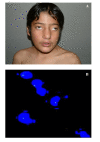Prevalence of 22q11.2 microdeletion in 146 patients with cardiac malformation in a referral hospital of North India
- PMID: 20573211
- PMCID: PMC2912258
- DOI: 10.1186/1471-2350-11-101
Prevalence of 22q11.2 microdeletion in 146 patients with cardiac malformation in a referral hospital of North India
Abstract
Background: The 22q11.2 microdeletion syndrome is a common condition that is associated with cardiac as well as extra-cardiac manifestations. Its prevalence and manifestations from north India has not been reported. This study was designed to determine the prevalence and ability of clinical criteria to predict 22q11.2 microdeletion.
Methods: A total of 146 cases of cardiac malformation requiring tertiary care at a teaching hospital were prospectively screened for 22q11.2 microdeletion using fluorescence in situ hybridization test. Detailed clinical information was obtained as per guidelines of Tobias, et al (1999).
Results: Nine out of 146 patients (6.16%) was found to have 22q11.2 microdeletion. All the positive patients showed the presence of extra-cardiac features of 22q11.2 microdeletion syndrome. None of the cases with isolated cardiac defect were positive for microdeletion.
Conclusions: It seems that 22q11.2 microdeletion syndrome is over-suspected in children with isolated congenital heart defects. Screening for 22q11.2 microdeletion should be considered in those cardiac malformation cases which have extra-cardiac manifestations in the form of facial dysmorphism and hypocalcaemia.
Figures


References
-
- Tan KB, Chew SK, Yeo GS. 22q11.2 deletion syndrome in Singapore (2000-2003): a case for active ascertainment. Singapore Med J. 2008;49:286–289. - PubMed
Publication types
MeSH terms
LinkOut - more resources
Full Text Sources
Medical

